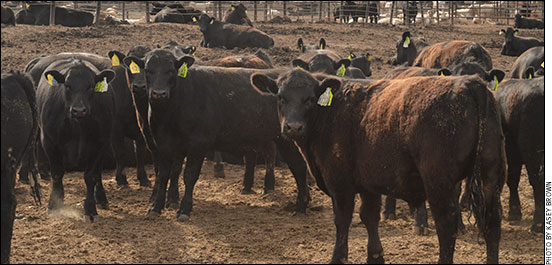
A Search for BRD Solutions
New research finds protein vulnerability to BRD; developing test.
BRD (bovine respiratory disease) costs the beef industry more than any other single disease in death losses and treatment costs. Studies have shown that at least $500 million are spent each year on drugs and vaccines that alleviate only part of the problem.
According to Steve Carlson, veterinarian and researcher at Iowa State University and scientist at AeroGenics LLC, “BRD frequently occurs when calves are transported from ranch of origin to the feedlot. This disease is seen in 10% of the 3 million calves transported each year, and about 40% of those affected calves perish,” he says.
“This translates into cost of about $150 per animal across the board in production loss, death losses, labor, vaccines and antibiotics,” says Carlson. “The sick and dead ones take profit away from the others. It would be nice to not have to worry about the 90% that don’t get BRD — just put them right into the feedlot as they arrive — and only worry about the other 10%. It would help to know which animals are part of that 10% so they can be dealt with to minimize treatment costs and losses,” says Carlson.
A new company, AeroGenics, was created to help identify those 10%.
The research first looked for a genetic aspect for BRD resistance. “This did not pan out but led us into another path where we found a specific protein that some cattle over-express during this disease,” says Carlson.
“In BRD, the stress of shipping induces the over-expression of a lung protein in a certain population of cattle. This lung protein is involved in a hyper-inflammatory response that damages the lungs. So we targeted the over-expressed lung protein as a predictor for development of BRD,” he says.
“Some animals over-express this protein, and we can detect/predict this as they come off the truck at the feedlot. We’ve developed a blood-based test, and plan to convert it into an ELISA (enzyme-linked immuno-sorbent assay) format in which a drop of blood could be taken from the animal and put into an on-farm test kit, such as the SNAP® kits sold by IDEXX,” says Carlson.
“There are many SNAP kits available for tests used in animal health. Another option could be a simple color-change test. The animal could be tested as it arrives in the feedlot and you’d get an answer within 10 minutes whether it is susceptible to BRD. Then the calves could be sorted.”
Susceptible ones could be put in a pen by themselves and managed differently, monitored closely, or treated prophylactically with a drug that blocks the over-expressed protein and helps alleviate signs of BRD, he adds.
“The prognostic ELISA test being developed might cost about $8 per calf, or less. The $8 figure is based on [the] wholesale price that companies like IDEXX charge veterinarians for some SNAP tests. The BRD test would be a direct sale to the cattle producer,” says Carlson.
His research has shown that the over-expression of this hyper-inflammatory lung protein is not based on genetics.
“It may be due to factors in the environment of the animal that creates BRD susceptibility by making an over-abundance of this protein during transportation/stress,” Carlson explains. Being able to detect this protein excess could be a valuable predictor of knowing which animals need more attention to prevent BRD.

Editor’s Note: Heather Smith Thomas is a freelancer and cattlewoman from Salmon, Idaho.





